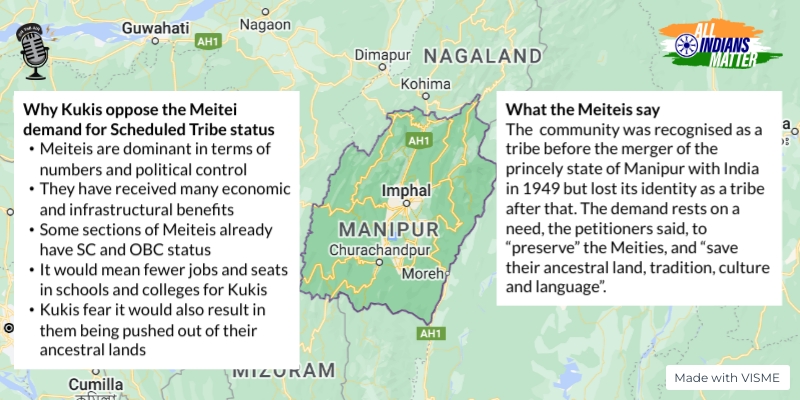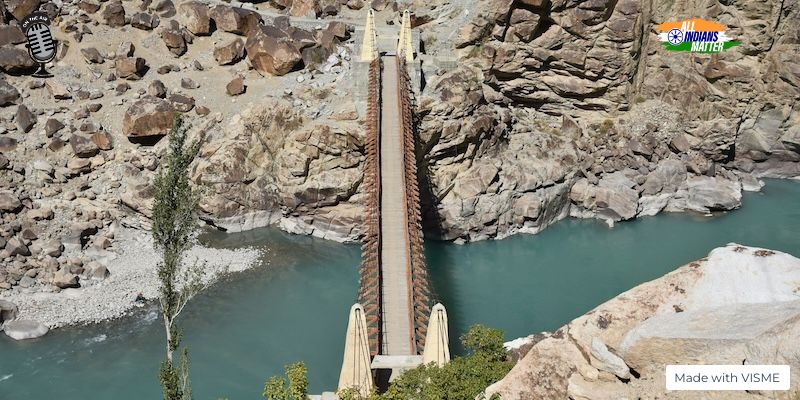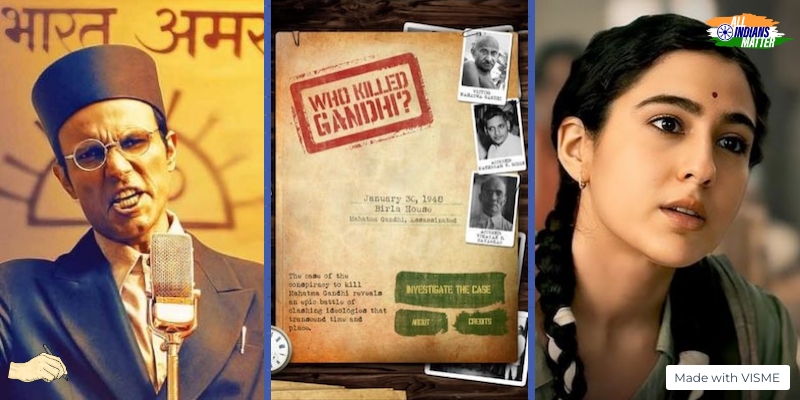Ashraf Engineer
May 13, 2023
EPISODE TRANSCRIPT
Hello and welcome to All Indians Matter. I am Ashraf Engineer.
As Manipur reaches for normalcy, citizens are picking up the pieces of their shattered lives. More than 60 people were killed in ethnic clashes that broke out on May 3 as mobs targeted homes, cars, churches and temples. According to the state government, 231 people were injured and 1,700 structures burnt. Thousands were displaced from their homes and turned into internal refugees overnight. What are the ethnic faultlines that led to the north-eastern state erupting?
SIGNATURE TUNE
At the heart of the divisions in Manipur lies the demand of the majority Meitei community, a largely Hindu ethnic group that accounts for 53% of the state’s population, for inclusion in the Scheduled Tribes category. The Meiteis have been demanding this for years because it would mean access to forestlands and a proportion of government jobs and seats in educational institutions.
The communities already recognised as Scheduled Tribes, especially Kukis, who live in the hill districts and are largely Christian, fear that they would lose control over their ancestral forestland if the Meitei demand is accepted. It would also mean a shrinking pie of government jobs and other benefits for them.
Traditionally, Scheduled Tribes are among the most disadvantaged groups that have been denied access to education and jobs, which led to the creation of reservations for them in an effort to correct the imbalance. With the benefits such categorisation brings, many groups have demanded inclusion in the list.
The clashes began after the All Tribal Students Union Manipur held a march in all districts opposing a Manipur High Court order that asked the state government to recommend the Meitei demand to the Centre. Within 24 hours, the violence had escalated enough for the Centre to invoke Article 355 of the Constitution, an emergency provision that empowers it to take the steps needed to protect a state against internal disturbances and external attacks. Convoys of trucks belonging to the Army, the Assam Rifles and the Rapid Action Force rolled into the state to bring the situation under control.
The demand for Scheduled Tribes status is thought to have been first raised in 2012 by the Scheduled Tribes Demand Committee of Manipur.
In their plea before the High Court, the petitioners said the Meitei community was recognised as a tribe before the merger of the princely state of Manipur with India in 1949 but lost its identity as a tribe after that. The demand rested on a need, the petitioners said, to “preserve” the Meities, and “save their ancestral land, tradition, culture and language”.
The Scheduled Tribes Demand Committee of Manipur had, in pleas to the state and Central governments, said “the community has been victimised without any constitutional safeguards to date. The Meitein/Meetei have been gradually marginalised in their ancestral land. Their population which was 59% of the total population of Manipur in 1951 has now been reduced to 44% as per 2011 Census data”.
The Kukis responded by pointing out that the Meiteis dominate not just the population but politics too with 40 out of 60 state Assembly constituencies lying in the valley where they stay. The Meiteis are an advanced community and should not be eligible for Scheduled Tribes status, the Kukis argue.
Besides, they point out, the Manipuri language of the Meiteis is included in the Eighth Schedule of the Constitution, and that sections of the community already have Scheduled Castes or Other Backward Classes status.
Thongkholal Haokip, Assistant Professor at Jawaharlal Nehru University’s Centre for the Study of Law and Governance, wrote in a paper titled ‘The Politics of Scheduled Tribe Status in Manipur’: “The claim that Meiteis need ST status to protect their culture and identity is self-defeating. The Meiteis are a dominant group controlling the state and its apparatuses. The state has been protecting their cultural, political and economic rights. As such, their culture and identity are in no way endangered…” He added: “To the hill tribal people of Manipur, the demand for ST status is a ploy to attenuate the fervent political demands of the Kukis and Nagas, as well as a tacit strategy of the dominant valley dwellers to make inroads into the hill areas of the state.”
Of course, clashes such as those we witnessed last week are rarely about one thing alone. Tensions between Meiteis and Kukis have been simmering for years over several issues, including land rights and suppression of minority groups.
The Meteis dominate the state government and have benefited from more economic and infrastructural benefits than any other ethnic group. They live in the more developed but smaller Imphal Valley, which accounts for 10% of Manipur’s landmass. The Naga and Kuki groups are predominantly residents of the agriculturally rich and larger protected hill districts.
Here’s where land rights come in. The Nagas and Kukis say the change in Meitei status could result in their steady removal from a protected area they have lived in for decades.
There are external considerations too. Tensions in Manipur have intensified after the 2021 coup in neighbouring Myanmar that forced thousands of ethnically Chin people to flee the violent military crackdown. The Kukis are from the same ethnic group as the Chins and they say the state government has unfairly cracked down the refugees.
Earlier, in late April, a mob attacked a gym in Churachandpur that was to be inaugurated by Chief Minister Biren Singh. This followed the state government sending notices since August 2022 claiming that 38 villages in the Churachandpur-Khoupum Protected Forest area are illegal settlements and its residents are encroachers. An eviction drive followed, which too resulted in clashes. Chief Minister Singh reportedly said that the people living there “were encroaching reserved forests, protected forests and wildlife sanctuaries for poppy plantation and drugs business”.
The Kukis said the eviction was a violation of Article 371C, which conferred some administrative autonomy to the tribal-dominated hill areas.
As the violence spiralled last week in Manipur, the Supreme Court said there was a need to provide basic amenities in relief camps, take “all necessary precautions for the rehabilitation of the displaced persons”, and to “protect places of religious worship”.
As of now, many seem to be returning from the relief camps and curfew is being eased. The state government said that only 4,000 of the 35,000 displaced people remain in the camps. These numbers, of course, are not independently verified.
However, Manipur is far from normal. There is simmering discontent underneath. The communal fissures run deep and it doesn’t seem likely that the two warring communities will back down any time soon.
Thank you all for listening. Please visit allindiansmatter.in for more columns and audio podcasts. You can follow me on Twitter at @AshrafEngineer and @AllIndiansCount. Search for the All Indians Matter page on Facebook. On Instagram, the handle is @AllIndiansMatter. Email me at editor@allindiansmatter.in. Catch you again soon.






